Analyzing the Effects of Platelet-Rich Plasma in Wound Healing
VerifiedAdded on 2022/11/16
|5
|1136
|142
Report
AI Summary
This report delves into the application of platelet-rich plasma (PRP) in wound healing, exploring its mechanisms and efficacy. PRP, an autologous therapeutic technique, is discussed for its capacity to stimulate and accelerate wound recovery. The report highlights the role of platelets, chemokines, growth factors, and cytokines within PRP, and their impact on wound healing at the molecular and cellular levels. It reviews studies demonstrating PRP's effectiveness in reducing wound area, promoting faster closure, and alleviating pain compared to conventional treatments like saline gauze or topical treatments. The pathophysiology of wound healing is outlined, emphasizing the stages of hemostasis, inflammation, proliferation, and remodeling, and the role of growth factors. The report also discusses PRP's antimicrobial properties and its ease of production, advocating for its use in wound care. Furthermore, it considers the importance of debridement and appropriate dressings, and the reduced infection rates and pain scores associated with PRP treatment.
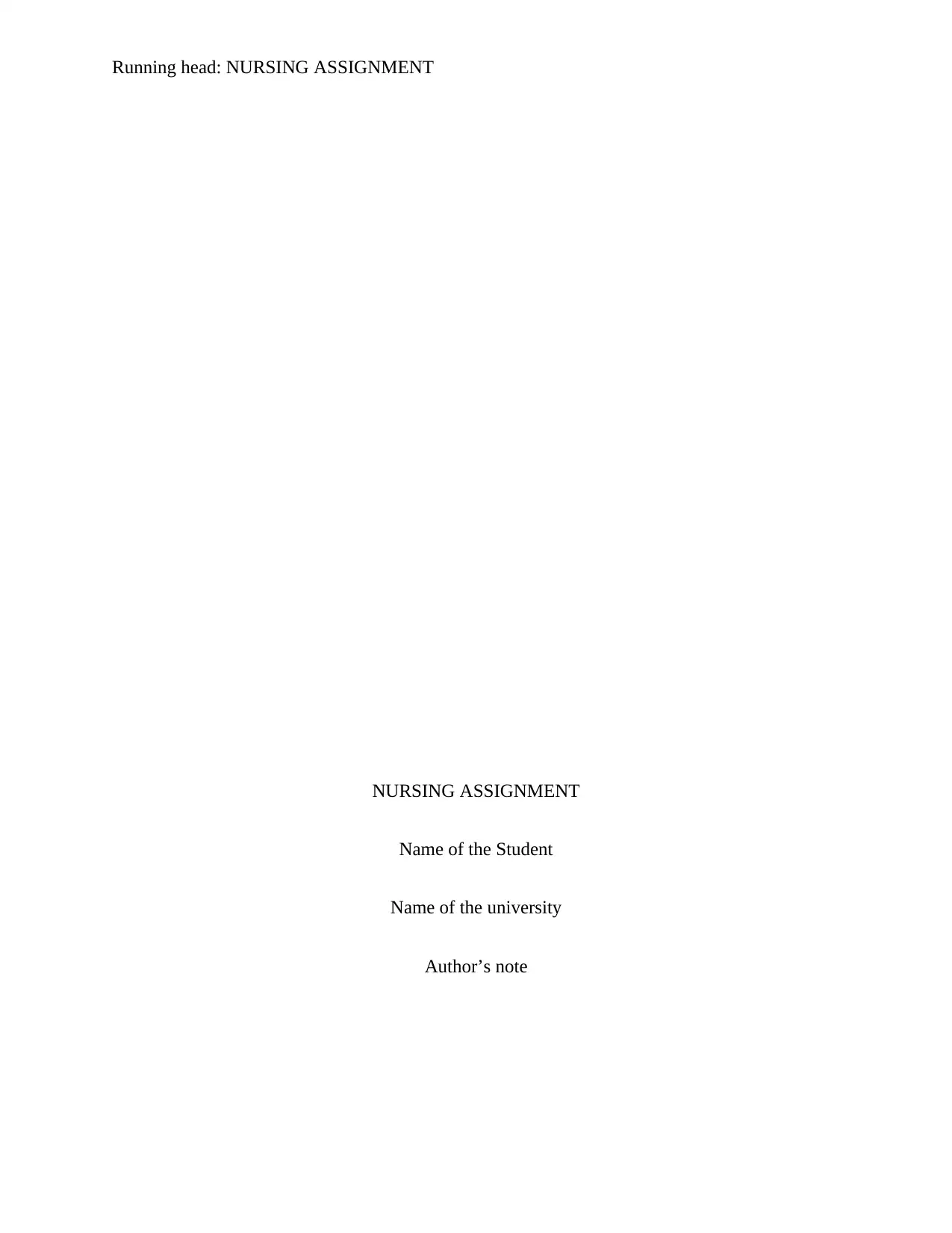
Running head: NURSING ASSIGNMENT
NURSING ASSIGNMENT
Name of the Student
Name of the university
Author’s note
NURSING ASSIGNMENT
Name of the Student
Name of the university
Author’s note
Paraphrase This Document
Need a fresh take? Get an instant paraphrase of this document with our AI Paraphraser
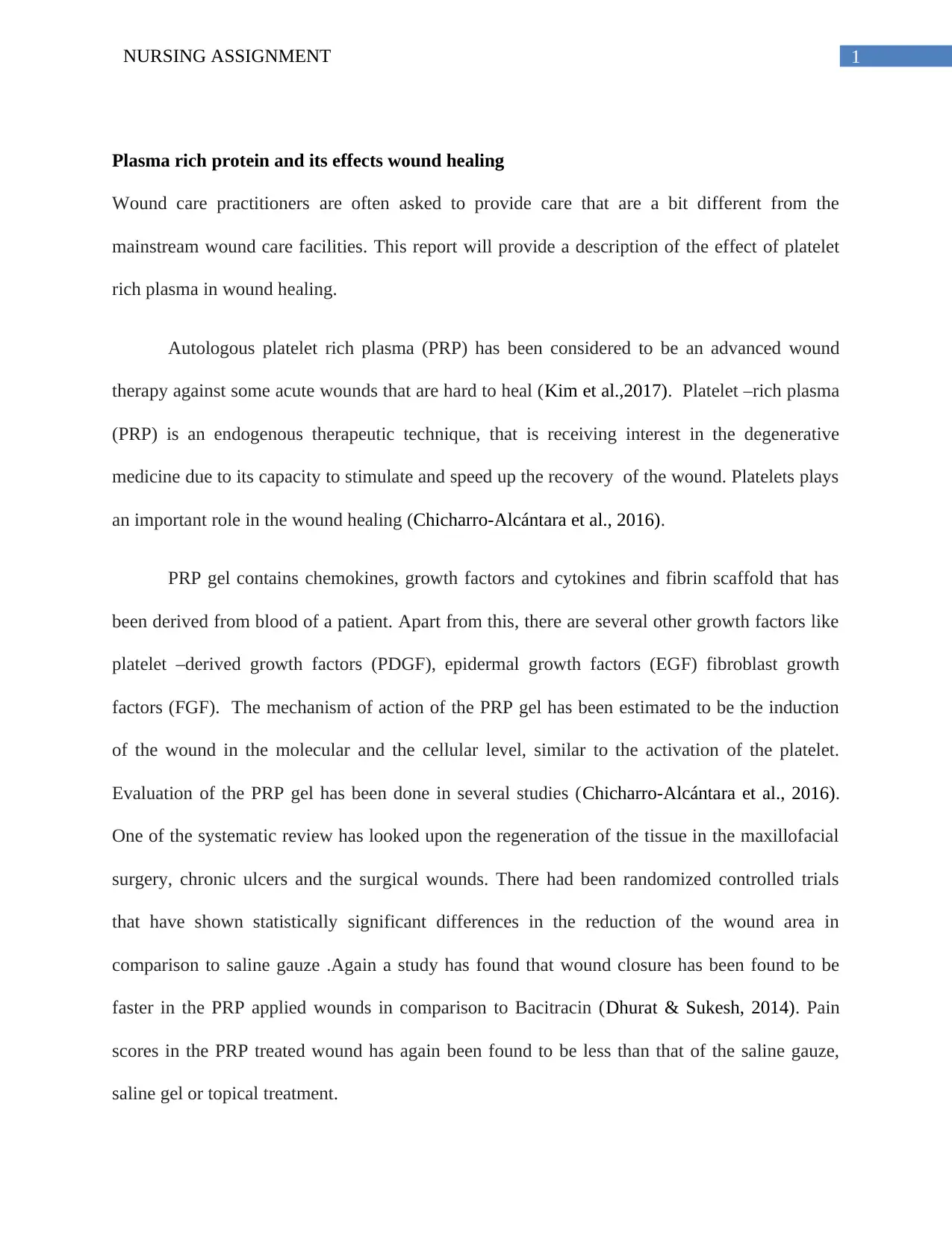
1NURSING ASSIGNMENT
Plasma rich protein and its effects wound healing
Wound care practitioners are often asked to provide care that are a bit different from the
mainstream wound care facilities. This report will provide a description of the effect of platelet
rich plasma in wound healing.
Autologous platelet rich plasma (PRP) has been considered to be an advanced wound
therapy against some acute wounds that are hard to heal (Kim et al.,2017). Platelet –rich plasma
(PRP) is an endogenous therapeutic technique, that is receiving interest in the degenerative
medicine due to its capacity to stimulate and speed up the recovery of the wound. Platelets plays
an important role in the wound healing (Chicharro-Alcántara et al., 2016).
PRP gel contains chemokines, growth factors and cytokines and fibrin scaffold that has
been derived from blood of a patient. Apart from this, there are several other growth factors like
platelet –derived growth factors (PDGF), epidermal growth factors (EGF) fibroblast growth
factors (FGF). The mechanism of action of the PRP gel has been estimated to be the induction
of the wound in the molecular and the cellular level, similar to the activation of the platelet.
Evaluation of the PRP gel has been done in several studies (Chicharro-Alcántara et al., 2016).
One of the systematic review has looked upon the regeneration of the tissue in the maxillofacial
surgery, chronic ulcers and the surgical wounds. There had been randomized controlled trials
that have shown statistically significant differences in the reduction of the wound area in
comparison to saline gauze .Again a study has found that wound closure has been found to be
faster in the PRP applied wounds in comparison to Bacitracin (Dhurat & Sukesh, 2014). Pain
scores in the PRP treated wound has again been found to be less than that of the saline gauze,
saline gel or topical treatment.
Plasma rich protein and its effects wound healing
Wound care practitioners are often asked to provide care that are a bit different from the
mainstream wound care facilities. This report will provide a description of the effect of platelet
rich plasma in wound healing.
Autologous platelet rich plasma (PRP) has been considered to be an advanced wound
therapy against some acute wounds that are hard to heal (Kim et al.,2017). Platelet –rich plasma
(PRP) is an endogenous therapeutic technique, that is receiving interest in the degenerative
medicine due to its capacity to stimulate and speed up the recovery of the wound. Platelets plays
an important role in the wound healing (Chicharro-Alcántara et al., 2016).
PRP gel contains chemokines, growth factors and cytokines and fibrin scaffold that has
been derived from blood of a patient. Apart from this, there are several other growth factors like
platelet –derived growth factors (PDGF), epidermal growth factors (EGF) fibroblast growth
factors (FGF). The mechanism of action of the PRP gel has been estimated to be the induction
of the wound in the molecular and the cellular level, similar to the activation of the platelet.
Evaluation of the PRP gel has been done in several studies (Chicharro-Alcántara et al., 2016).
One of the systematic review has looked upon the regeneration of the tissue in the maxillofacial
surgery, chronic ulcers and the surgical wounds. There had been randomized controlled trials
that have shown statistically significant differences in the reduction of the wound area in
comparison to saline gauze .Again a study has found that wound closure has been found to be
faster in the PRP applied wounds in comparison to Bacitracin (Dhurat & Sukesh, 2014). Pain
scores in the PRP treated wound has again been found to be less than that of the saline gauze,
saline gel or topical treatment.
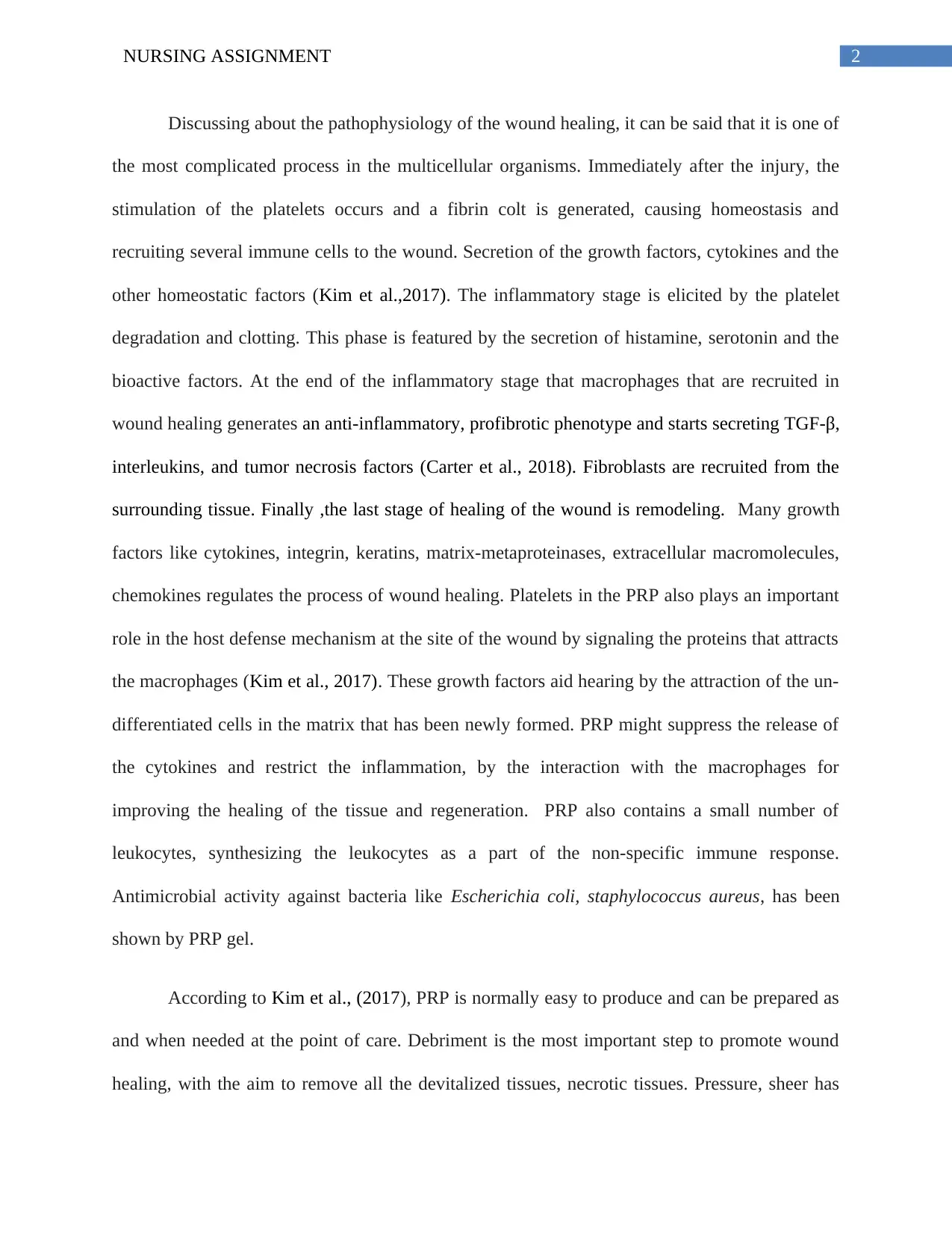
2NURSING ASSIGNMENT
Discussing about the pathophysiology of the wound healing, it can be said that it is one of
the most complicated process in the multicellular organisms. Immediately after the injury, the
stimulation of the platelets occurs and a fibrin colt is generated, causing homeostasis and
recruiting several immune cells to the wound. Secretion of the growth factors, cytokines and the
other homeostatic factors (Kim et al.,2017). The inflammatory stage is elicited by the platelet
degradation and clotting. This phase is featured by the secretion of histamine, serotonin and the
bioactive factors. At the end of the inflammatory stage that macrophages that are recruited in
wound healing generates an anti-inflammatory, profibrotic phenotype and starts secreting TGF-β,
interleukins, and tumor necrosis factors (Carter et al., 2018). Fibroblasts are recruited from the
surrounding tissue. Finally ,the last stage of healing of the wound is remodeling. Many growth
factors like cytokines, integrin, keratins, matrix-metaproteinases, extracellular macromolecules,
chemokines regulates the process of wound healing. Platelets in the PRP also plays an important
role in the host defense mechanism at the site of the wound by signaling the proteins that attracts
the macrophages (Kim et al., 2017). These growth factors aid hearing by the attraction of the un-
differentiated cells in the matrix that has been newly formed. PRP might suppress the release of
the cytokines and restrict the inflammation, by the interaction with the macrophages for
improving the healing of the tissue and regeneration. PRP also contains a small number of
leukocytes, synthesizing the leukocytes as a part of the non-specific immune response.
Antimicrobial activity against bacteria like Escherichia coli, staphylococcus aureus, has been
shown by PRP gel.
According to Kim et al., (2017), PRP is normally easy to produce and can be prepared as
and when needed at the point of care. Debriment is the most important step to promote wound
healing, with the aim to remove all the devitalized tissues, necrotic tissues. Pressure, sheer has
Discussing about the pathophysiology of the wound healing, it can be said that it is one of
the most complicated process in the multicellular organisms. Immediately after the injury, the
stimulation of the platelets occurs and a fibrin colt is generated, causing homeostasis and
recruiting several immune cells to the wound. Secretion of the growth factors, cytokines and the
other homeostatic factors (Kim et al.,2017). The inflammatory stage is elicited by the platelet
degradation and clotting. This phase is featured by the secretion of histamine, serotonin and the
bioactive factors. At the end of the inflammatory stage that macrophages that are recruited in
wound healing generates an anti-inflammatory, profibrotic phenotype and starts secreting TGF-β,
interleukins, and tumor necrosis factors (Carter et al., 2018). Fibroblasts are recruited from the
surrounding tissue. Finally ,the last stage of healing of the wound is remodeling. Many growth
factors like cytokines, integrin, keratins, matrix-metaproteinases, extracellular macromolecules,
chemokines regulates the process of wound healing. Platelets in the PRP also plays an important
role in the host defense mechanism at the site of the wound by signaling the proteins that attracts
the macrophages (Kim et al., 2017). These growth factors aid hearing by the attraction of the un-
differentiated cells in the matrix that has been newly formed. PRP might suppress the release of
the cytokines and restrict the inflammation, by the interaction with the macrophages for
improving the healing of the tissue and regeneration. PRP also contains a small number of
leukocytes, synthesizing the leukocytes as a part of the non-specific immune response.
Antimicrobial activity against bacteria like Escherichia coli, staphylococcus aureus, has been
shown by PRP gel.
According to Kim et al., (2017), PRP is normally easy to produce and can be prepared as
and when needed at the point of care. Debriment is the most important step to promote wound
healing, with the aim to remove all the devitalized tissues, necrotic tissues. Pressure, sheer has
⊘ This is a preview!⊘
Do you want full access?
Subscribe today to unlock all pages.

Trusted by 1+ million students worldwide
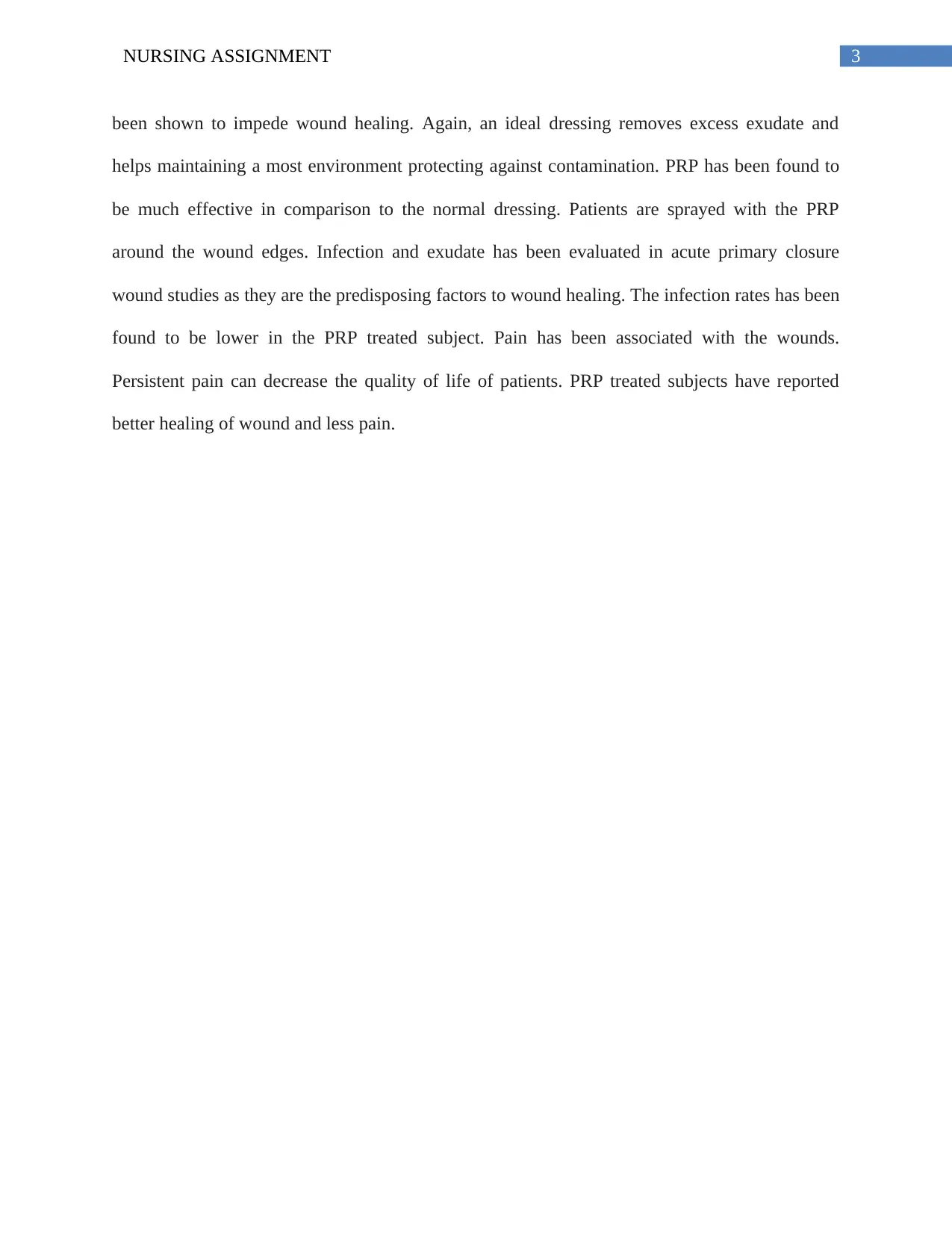
3NURSING ASSIGNMENT
been shown to impede wound healing. Again, an ideal dressing removes excess exudate and
helps maintaining a most environment protecting against contamination. PRP has been found to
be much effective in comparison to the normal dressing. Patients are sprayed with the PRP
around the wound edges. Infection and exudate has been evaluated in acute primary closure
wound studies as they are the predisposing factors to wound healing. The infection rates has been
found to be lower in the PRP treated subject. Pain has been associated with the wounds.
Persistent pain can decrease the quality of life of patients. PRP treated subjects have reported
better healing of wound and less pain.
been shown to impede wound healing. Again, an ideal dressing removes excess exudate and
helps maintaining a most environment protecting against contamination. PRP has been found to
be much effective in comparison to the normal dressing. Patients are sprayed with the PRP
around the wound edges. Infection and exudate has been evaluated in acute primary closure
wound studies as they are the predisposing factors to wound healing. The infection rates has been
found to be lower in the PRP treated subject. Pain has been associated with the wounds.
Persistent pain can decrease the quality of life of patients. PRP treated subjects have reported
better healing of wound and less pain.
Paraphrase This Document
Need a fresh take? Get an instant paraphrase of this document with our AI Paraphraser
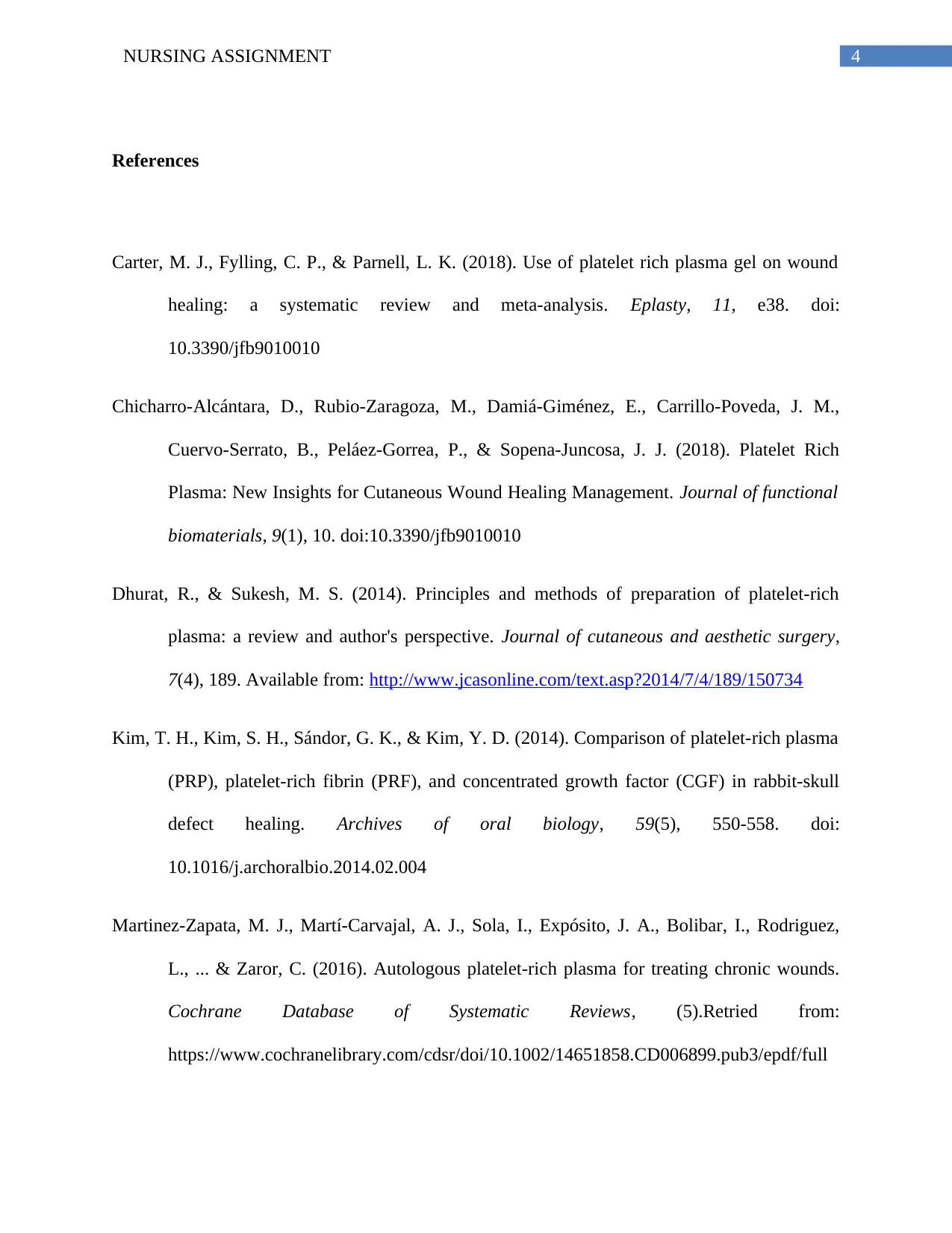
4NURSING ASSIGNMENT
References
Carter, M. J., Fylling, C. P., & Parnell, L. K. (2018). Use of platelet rich plasma gel on wound
healing: a systematic review and meta-analysis. Eplasty, 11, e38. doi:
10.3390/jfb9010010
Chicharro-Alcántara, D., Rubio-Zaragoza, M., Damiá-Giménez, E., Carrillo-Poveda, J. M.,
Cuervo-Serrato, B., Peláez-Gorrea, P., & Sopena-Juncosa, J. J. (2018). Platelet Rich
Plasma: New Insights for Cutaneous Wound Healing Management. Journal of functional
biomaterials, 9(1), 10. doi:10.3390/jfb9010010
Dhurat, R., & Sukesh, M. S. (2014). Principles and methods of preparation of platelet-rich
plasma: a review and author's perspective. Journal of cutaneous and aesthetic surgery,
7(4), 189. Available from: http://www.jcasonline.com/text.asp?2014/7/4/189/150734
Kim, T. H., Kim, S. H., Sándor, G. K., & Kim, Y. D. (2014). Comparison of platelet-rich plasma
(PRP), platelet-rich fibrin (PRF), and concentrated growth factor (CGF) in rabbit-skull
defect healing. Archives of oral biology, 59(5), 550-558. doi:
10.1016/j.archoralbio.2014.02.004
Martinez‐Zapata, M. J., Martí‐Carvajal, A. J., Sola, I., Expósito, J. A., Bolibar, I., Rodriguez,
L., ... & Zaror, C. (2016). Autologous platelet‐rich plasma for treating chronic wounds.
Cochrane Database of Systematic Reviews, (5).Retried from:
https://www.cochranelibrary.com/cdsr/doi/10.1002/14651858.CD006899.pub3/epdf/full
References
Carter, M. J., Fylling, C. P., & Parnell, L. K. (2018). Use of platelet rich plasma gel on wound
healing: a systematic review and meta-analysis. Eplasty, 11, e38. doi:
10.3390/jfb9010010
Chicharro-Alcántara, D., Rubio-Zaragoza, M., Damiá-Giménez, E., Carrillo-Poveda, J. M.,
Cuervo-Serrato, B., Peláez-Gorrea, P., & Sopena-Juncosa, J. J. (2018). Platelet Rich
Plasma: New Insights for Cutaneous Wound Healing Management. Journal of functional
biomaterials, 9(1), 10. doi:10.3390/jfb9010010
Dhurat, R., & Sukesh, M. S. (2014). Principles and methods of preparation of platelet-rich
plasma: a review and author's perspective. Journal of cutaneous and aesthetic surgery,
7(4), 189. Available from: http://www.jcasonline.com/text.asp?2014/7/4/189/150734
Kim, T. H., Kim, S. H., Sándor, G. K., & Kim, Y. D. (2014). Comparison of platelet-rich plasma
(PRP), platelet-rich fibrin (PRF), and concentrated growth factor (CGF) in rabbit-skull
defect healing. Archives of oral biology, 59(5), 550-558. doi:
10.1016/j.archoralbio.2014.02.004
Martinez‐Zapata, M. J., Martí‐Carvajal, A. J., Sola, I., Expósito, J. A., Bolibar, I., Rodriguez,
L., ... & Zaror, C. (2016). Autologous platelet‐rich plasma for treating chronic wounds.
Cochrane Database of Systematic Reviews, (5).Retried from:
https://www.cochranelibrary.com/cdsr/doi/10.1002/14651858.CD006899.pub3/epdf/full
1 out of 5
Related Documents
Your All-in-One AI-Powered Toolkit for Academic Success.
+13062052269
info@desklib.com
Available 24*7 on WhatsApp / Email
![[object Object]](/_next/static/media/star-bottom.7253800d.svg)
Unlock your academic potential
Copyright © 2020–2025 A2Z Services. All Rights Reserved. Developed and managed by ZUCOL.



